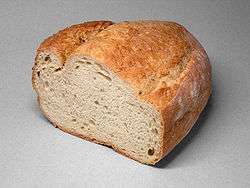Barm
Barm is the foam, or scum, formed on the top of liquor – fermented alcoholic beverages such as beer or wine,[1] or feedstock for hard liquor or industrial ethanol distillation – when fermenting. It was used to leaven bread, or set up fermentation in a new batch of liquor. Barm, as a leaven, has also been made from ground millet combined with must out of wine-tubs[2] and is sometimes used in English baking as a synonym for a natural leaven.[3] Various cultures derived from barm, usually Saccharomyces cerevisiae, became ancestral to most forms of brewer's yeast and baker's yeast currently on the market.
Other uses
In parts of North West England and Yorkshire, a barm or barm cake is a common term for a soft, floury bread roll: menus in chip shops offer chip barms consisting of chips in a bread roll, these are also known as "chip butties" in some areas. Other areas describe an identical roll as a "bap", "bread bun", "bread cake","batch" or "blaa". It is applied equally to yeast-leavened bread, without implying the use of sourdough or barm leavens.
In Ireland, barm is used in the traditional production of barmbrack, a fruited bread.
See also
| Look up barm in Wiktionary, the free dictionary. |
References
Notes
- ↑
 Chisholm, Hugh, ed. (1911). "Barm". Encyclopædia Britannica. 3 (11th ed.). Cambridge University Press. p. 407.
Chisholm, Hugh, ed. (1911). "Barm". Encyclopædia Britannica. 3 (11th ed.). Cambridge University Press. p. 407. - ↑ Botham's of Whitby. "The story behind a loaf of bread".
- ↑ Reinhart, Peter (1998). Crust and Crumb. Berkeley, CA: Ten Speed Press. ISBN 1-58008-802-3. Reinhart derived the term from his training under Monica Spiller.
